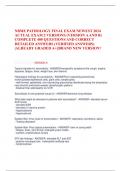NBME PATHOLOGY FINAL EXAM NEWEST 2024
ACTUAL EXAM 2 VERSIONS (VERSION A AND B)
COMPLETE 400 QUESTIONS AND CORRECT
DETAILED ANSWERS (VERIFIED ANSWERS)
|ALREADY GRADED A+||BRAND NEW VERSION!
VERSION A
Typical vignette for sarcoidosis - ANSWERnonspecific symptoms like cough, angina,
dyspnea, fatigue, fever, weight loss, skin lesions
Histological findings for sarcoidosis - ANSWERnon-caseating granulomas,
multinucleated epithelioid cells, giant cells, lymphocytes.
- well-formed, epithelioid, non-necrotizing granulomas distributed along the lymphatics
near bronchi and blood vessels (lymphangitic pattern)
- bilateral hilar adenopathy on CXR
Sarcoidosis is one potential cause of - ANSWERrestrictive lung disease
What labs might be elevated in patients with sarcoidosis? - ANSWER- elevated serum
ACE levels
- elevated ESR
- elevated C-reactive protein
- hypercalcemia
- hypercalciuria
Epstein Barr Virus route of transmission - ANSWER- respiratory secretions, saliva
- "kissing diseases"
Epstein-Barr Virus typical presentation - ANSWER- teen or young adult
- fatigue, fever, sore throat, enlarged lymph nodes
- swollen, erythematous tonsils
EPV lab findings - ANSWER- elevated ALT and AST
- positive monospot test - heterophile antibody test
- lymphocytosis
,Where do kidney stones form? - ANSWERMay occur anywhere along the urinary tract:
renal tubules, renal pelvis, ureters, bladder, and/or urethra.
1. ureteropelvic junction: where renal pelvis transitions into the ureter
2. ureterovesical junction: where ureter meets urinary bladder
3. mid-ureter
4. distal ureter
What are the different nephrolithiasis conditions (3)? - ANSWER- staghorn calculus:
mixture of magnesium ammonium phosphate and calcium phosphate. Arise in a setting
of chronic urinary infection with urease splitting bacteria like Proteus mirabilis
- calcium oxalate stones: most common, occurs when calcium binds with oxalate due to
excess oxalate. Treated with diet changes, increased fluid intake, sometimes thiazides.
- uric acid stones: excess purines. treated by increasing urine pH, diet change, fluid
intake.
Pathogenesis of PSGN - ANSWER- Type III hypersensitivity reaction (immune complex
mediated); circulating or planted antigen
PSGN light microscopy - ANSWERdiffuse endocapillary proliferation; leukocytic
infiltration
PSGN DIF - ANSWERgranular IgG and C3 in GBM and mesangium
PSGN: Electron Microscopy - ANSWERSubepithelial humps, subendothelial deposits in
early disease stages
PSGN clinical presentation - ANSWER- recent history of group A strep
- can range from asymptomatic microscopic hematuria to full-blown nephritic syndrome
Rapidly progessive glomerulonephritis (RPGN) clinical presentation - ANSWER-
nephritic syndrome, rapid progression
PSGN histologic findings - ANSWER- glomeruli are hypercellular and enlarged
- global and diffuse
- interstitial edema and inflammation
- presence of WBCs in glomerular capillary loops, damage to glomeruli, RBCs and RBC
casts in the tubules all lead to WBCs, RBCs, and RBC casts in the urine.
PSGN lab findings - ANSWER- RBCs, RBC casts, dysmorphic RBCs, WBCs, and
protein in urine
- elevated ASO titers
- decreased C3 and normal C4 serum complement levels
- Throat and skin cultures often negative
Describe Goodpasture Syndrome - ANSWER- due to anti-GBM Abs
,- causes glomerulonephritis and pulmonary hemorrhage
What is the most characteristic finding of RPGN? - ANSWER- glomerular crescents
consisting of proliferating parietal cells, monocytes, macrophages, T lymphocytes,
plasma proteins, chemokines, cytokines, and often fibrin strands.
RPGN light microscopy - ANSWER- extracapillary proliferation with crescents; necrosis
What are three potential causes of RPGN? - ANSWER1. Goodpasture Syndrome
2. Granulomatosis with polyangiitis
3. Systemic lupus erythematosus
Describe the IF staining patterns of RPGN with respect to the three potential causes. -
ANSWER- Goodpasture Syndrome: linear staining of GBM with IgG
- Granulomatosis with polyangiitis: no deposits
- SLE: granular deposits
RPGN electron microscopy - ANSWER- wrinkling of the GBM with focal disruptions is
present in all types of the disease
What kind of hypersensitivity reaction is Goodpasture syndrome? - ANSWERType II
(antibody mediated)
Treatment for Goodpasture syndrome - ANSWER- intensive plasmapheresis
- corticosteroids
- cytotoxic agents
Describe minimal change disease MOA - ANSWER- unknown etiology but thought to be
immune-mediated
- damage to podocyte foot processes allows leakage of albumin into the urinary space
(nephrotic)
MCD histologic findings - ANSWER- most glomeruli are normal
- cells in PCT may have foamy or granular cytoplasm due to lipid and protein resorption
MCD DIF findings - ANSWER- negative
MCD, electron microscopy - ANSWER- effacement of foot processes, no deposits
How does excessive proteinuria in MCD cause edema? - ANSWER- loss of protein
through urine causes hypoproteinemia, which results in decreased intravascular colloid
osmotic pressure.
- fluid escapes into interstitium, decreases plasma volume and GFR
- Activation of RAAS and release of natriuretic peptides which causes water retention
, How does MCD cause hypercholesterolemia? - ANSWERSignificant hypoproteinemia
leads to compensatory protein synthesis by the liver, including lipoproteins.
What is the treatment for MCD? - ANSWERcorticosteroids
Membranous Nephropathy pathogenesis - ANSWER- IgG4 Abs are directed against a
podocyte membrane antigen like PLA2R. These Abs can activate the MAC and damage
podocytes.
How is MN treatment different from MCD? - ANSWERMN does not respond well to
corticosteroids
MN clinical manifestations - ANSWER- edema and ascites from hypoalbuminemia
- hypercoagulable state with renal vein or DVT from loss of antithrombin 3, or proteins C
or S in urine
- hypercholesterolemia
- hypogammaglobulinemia from urinary loss (nonselective proteinuria)
MN histologic findings - ANSWER- enlarged glomeruli but normal cellularity
- peripheral capillary walls diffusely thickened
- spike and dome appearance
- segmental or global sclerosis
- interstitial mononuclear inflammation and foamy proximal tubular epithelial cells
MN light microscopy - ANSWERdiffuse capillary wall thickening
MN DIF - ANSWER- granular IgG and C3 along GBM; diffuse
MN electron microscopy - ANSWERsubepithelial deposits
foot process effacement
What are some common causes of secondary MN? - ANSWER- malignancies
- infections
- drugs
- toxins
- autoimmune diseases
- SLE
Cause of IgA nephropathy - ANSWERIgA immune deposition in the glomerular
mesangium
IgA nephropathy pathogenesis - ANSWERabnormally glycosylated IgA1 molecules from
mucosa expose hidden isotopes, leading to immune complex formation in the
circulation. These complexes deposit in the mesangium.
Clinical presentation of IgA nephropathy - ANSWERrecurrent hematuria or proteinuria




